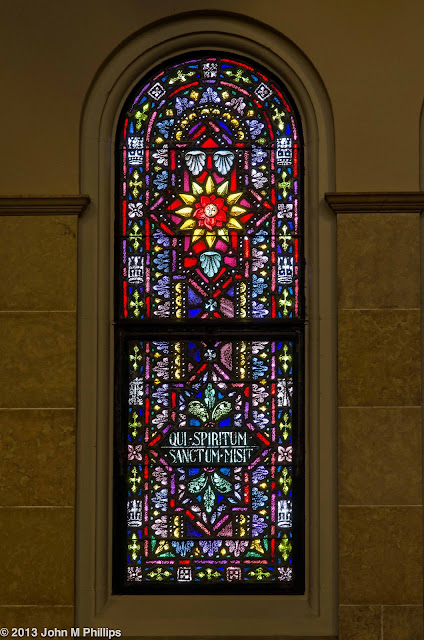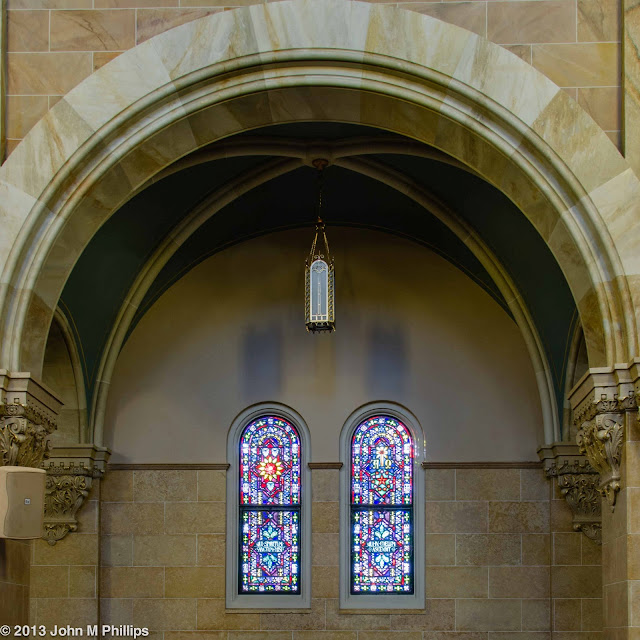On Saturday morning, April 20, the weather was sunny and crisp, and I made my way back to the basilica at Holy Hill in Hubertus, Wisconsin, a place I had visited last November. At 8:30 a.m. the church was quiet, and I was able to take photos for over an hour. Although the sun was starting to stream in the stained glass windows and most of the lights in the sanctuary were on, the amount of light in the church was still quite low relative to the outdoors. Moreover, for a number of the shots I was using a fairly narrow aperture, which translated to relatively long exposure times (10 seconds or more for some shots), so I was using my tripod.
I did take a few wider angle shots. (I say "wider angle" rather than "wide angle" because I do not have a true wide angle lens--the lens I use is a Nikkor 24-120mm f/4--and my Nikon D7000 camera has a sensor that crops down the image being captured by the lens.) Here are views of the front . . .
back . . .
and side of the sanctuary.
I also took a shot of the exterior of the church . . .
although, given the temperature (high 20s) and blustery winds, I spent most of my time on the interior. In this shot I was trying to take advantage of the angle of the simple, low wall in the foreground to lead the viewer to the complexity of the entrance. Unfortunately, the wall was not particularly attractive, so I don't think the shot worked very well.
I also took a few shots of the intricate plaster work abundant throughout the sanctuary.
In this first shot I centered the face in the upper part of the image. In the shot below, I decided to place it off-center, which seems to work a bit better to my eye.
I did note the light coming through the stained glass and caught a few shots of individual windows.
In the original images, because the windows were set significantly higher than my camera, there was a perspective problem in that the windows' tops were further away than their bases, so the sides of the windows were not parallel. My software allows me to correct for this in post processing, giving the appearance of having the camera situated directly across from the windows. Looks OK, I think. I tried to underexpose these shots overall to avoid "blowing out" the light from the windows themselves. As a result, the walls appear somewhat underexposed.
I probably should have spent more time with the windows, but what caught my attention on this visit were the many arches throughout the interior of the sanctuary, and I wound up with a plethora of images of those architectural features--with a mixture of success and failure. Here, for example, is an image of one of the classic roman arches that frames two of the windows.
A problem with this shot is that I have clipped off the top of the arch. Below is a better shot.
Here there is ample space above the top of the arch. I like the additional space at the bottom of the windows also. These two shots are of the same arch, and the windows are virtually identical in size in the two shots. The "secret" is that the second shot was taken from farther away.
(I am not sure what has caused the darker areas above each of the windows. At first I thought it might be some sort of artifactual problem relating to the camera lens and the light coming through the windows. But the same darker areas appear also in other images taken from a very different angle, so the cause remains a mystery.)
The "corridors" on either side of the sanctuary have a very interesting ceiling structure. Here is a wider-angle shot of one of the corridors.
I spent a good deal of time trying out various perspectives in an attempt to capture the detail in these ceilings. Here is an off-center shot.
It's kind of nice that the photo includes some of the ornate plaster work at the bases of the arches, as well as the hanging light fixtures, but I can't get over the feeling that the lack of symmetry is creating an overall imbalance in the shot.
Here are a couple of more detailed (and symmetrical) shots of the ceiling areas.
Of the two, I feel the latter is the more interesting image, as in incorporates more of the lower arch. The two sides, strictly speaking, are not symmetrical, but I am OK with that.
I seem to have spent even more time trying to capture the complex arches involved with these corridors. Here are two similar shots, using a landscape orientation.
One of my goals with these shots was to place the light fixture in the lower right of the image. In the first shot I have isolated the light against a relatively plain background. (These are photos of two different arches and light fixtures.) Although something could be said for isolating the light fixture in the first shot, overall I believe the second shot is the better of the two. Incidentally, the second shot was taken at an aperture of f/13 and an exposure of a whopping 15 seconds.
Here is another, similar shot taken in a portrait orientation.
I liked the way the sconce lighting was reflecting off the wall in the lower right. There was a great disparity in the amount of light across this shot: The green of the ceiling was very dark relative to the lighter color of the marble walls and arch, and I had to work quite hard in post processing to bring some definition to the dark ceiling without washing out the marble. The problem with this shot is that I have clipped off the top of the arch as well as a portion of the support pillar on the left. Here is a better shot of the same structure.
Finally, I took some shots intended to feature the support columns. Here is one of those.
The plaster detail at the base of the arches is quite sharp in this image, which was shot at f/8 with an exposure of 3 seconds. However, the marble appears a bit washed out. I decided that this image might be more interesting as a black & white.
And here are a pair of similar shots taken in a landscape orientation.
Again, the focus on the detail work was quite good. In this case, I think there enough variation in the coloration of the marble to make this an interesting shot both in color and in black & white.
Of the Milwaukee area's two Roman Catholic basilicas, Holy Hill has by far the best location, being set at the top of a hill in the middle of the Kettle Moraine and surrounded by a large woods of deciduous trees. (The color in the fall can be stunning.) However, the interior of the other basilica, St. Josephat's on Milwaukee's south side, is much the more spectacular. Holy Hill's interior is interesting, though, and I am thankful that both churches permit amateur photographers like me to come in and take pictures.



















































